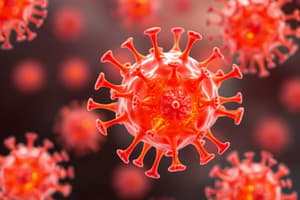Podcast
Questions and Answers
What is primarily responsible for immune privilege in sensitive tissues such as the eyes and brain?
What is primarily responsible for immune privilege in sensitive tissues such as the eyes and brain?
- T regulatory cells
- Exposure to pathogens
- Fas-FasL interactions and immunosuppressive cytokines (correct)
- High levels of immune cells
How do commensal bacteria affect the immune response in the gut?
How do commensal bacteria affect the immune response in the gut?
- They promote differentiation of Th0 cells towards effector T cells.
- They have no effect on the immune response.
- They make dendritic cells tolerogenic, promoting Treg differentiation. (correct)
- They induce aggressive inflammatory responses.
What can alterations in normal gut microbiota trigger?
What can alterations in normal gut microbiota trigger?
- Autoimmune and inflammatory gut disorders (correct)
- Increased efficacy of regulatory T cells
- Suppression of pathogen exposure
- Enhanced immune responses to allergens
What is the role of regulatory T cells in maintaining gut immune homeostasis?
What is the role of regulatory T cells in maintaining gut immune homeostasis?
Which of the following best describes immune privilege?
Which of the following best describes immune privilege?
What role do T regulatory cells (Tregs) play in the immune response?
What role do T regulatory cells (Tregs) play in the immune response?
Which of the following statements about natural Tregs (nTregs) is correct?
Which of the following statements about natural Tregs (nTregs) is correct?
What is the significance of the transcription factor Foxp3 in Tregs?
What is the significance of the transcription factor Foxp3 in Tregs?
Which statement accurately describes the subtypes of CD4+ Tregs?
Which statement accurately describes the subtypes of CD4+ Tregs?
What is a potential consequence of aberrant activation of Th1 and Th17 cells?
What is a potential consequence of aberrant activation of Th1 and Th17 cells?
Which molecules or factors contribute to the regulation of lymphocyte responses in the periphery?
Which molecules or factors contribute to the regulation of lymphocyte responses in the periphery?
What is the characteristic feature of immune privilege?
What is the characteristic feature of immune privilege?
How might intestinal microflora influence immune tolerance?
How might intestinal microflora influence immune tolerance?
Which surface markers are expressed by certain subsets of CD8+ regulatory T cells?
Which surface markers are expressed by certain subsets of CD8+ regulatory T cells?
What is one of the primary ways some CD8+ Treg cells exert their effects?
What is one of the primary ways some CD8+ Treg cells exert their effects?
What effect does IL-10 have on T cell activation?
What effect does IL-10 have on T cell activation?
Which molecules primarily contribute to the immunosuppressive effects on the immune system?
Which molecules primarily contribute to the immunosuppressive effects on the immune system?
What does the phenomenon of immune deviation achieve?
What does the phenomenon of immune deviation achieve?
What characterizes the mechanism by which nTregs suppress conventional CD4+ T cells?
What characterizes the mechanism by which nTregs suppress conventional CD4+ T cells?
How does TGF-beta influence T cell behavior?
How does TGF-beta influence T cell behavior?
Which cytokines are associated with iTreg cell differentiation?
Which cytokines are associated with iTreg cell differentiation?
In which tissue environment do Th2 responses typically dominate due to immune deviation?
In which tissue environment do Th2 responses typically dominate due to immune deviation?
Which type of T regulatory cell does not express Foxp3?
Which type of T regulatory cell does not express Foxp3?
Which of the following effects does TGF-beta NOT have?
Which of the following effects does TGF-beta NOT have?
What is the predominant immune response mediator secreted by Tr1 cells?
What is the predominant immune response mediator secreted by Tr1 cells?
How do iTreg cells inhibit naïve T cell activation?
How do iTreg cells inhibit naïve T cell activation?
Which of the following is true about Th3 cells?
Which of the following is true about Th3 cells?
What type of intercellular contact may lead to Tr1 and Th3 cell differentiation?
What type of intercellular contact may lead to Tr1 and Th3 cell differentiation?
Which statement accurately reflects the origin of iTreg cells?
Which statement accurately reflects the origin of iTreg cells?
Flashcards are hidden until you start studying
Study Notes
Regulation of Lymphocyte Responses
- Mechanisms in the periphery control the quality, intensity and duration of adaptive immune responses.
- These mechanisms involve regulatory T cells, immunosuppressive molecules, immune deviation, and immune privilege.
- The intestinal microflora also plays a role in controlling peripheral tolerance in the gut.
Regulatory T cells (Treg)
- Control the responses of activated conventional T cells.
- Help to balance the need for protective responses against pathogens and tumors, while avoiding excessive inflammation and autoimmune responses.
- Multiple types of CD4+ and CD8+ Tregs exist.
CD4+ Regulatory T cells (Treg)
- There are four main subtypes of CD4+ Tregs:
- nTreg cells: derived from thymic precursors.
- iTreg, Tr1, and Th3 cells: induced to differentiate from conventional T cells in secondary lymphoid tissues.
- These subtypes differ in derivation, phenotypic markers, suppressive mechanisms, and regulatory effects.
Thymus-Derived Treg (nTreg)
- Called "natural Treg" or "nTreg".
- Comprise 6-10% of peripheral CD4+ T cells.
- Display a TCR repertoire biased toward self-antigen.
- Characterized by expression of Foxp3, high levels of CD4, and CD25 (IL-2R alpha chain).
- Develop from precursors in the thymus and can be first identified at the DP stage.
- Express chemokine receptors allowing recirculation through secondary lymphoid tissues, migration to GALT, and residence in peripheral tissues.
nTreg functions
- Block proliferation and IL-2 production of conventional CD4+ T cells.
- Suppressive effects don't require cytokines but involve direct cell-to-cell contact independent of TCRs.
- Induced apoptosis in conventional T cells via Fas-FasL interactions.
- Mediate T cell death through high concentrations of negative regulators CTLA-4 and PD-1 on Treg
- May have direct effects on APCs, rendering them tolerogenic.
Induced Regulatory T cells (iTreg)
- Tolerogenic DCs can induce iTreg differentiation.
- Th0 cells interacting with mature DCs in a TGF-beta and IL-2-rich environment can become iTregs.
- Express CD4, CD25, and Foxp3.
- Suppress effector T cells by secreting IL-10 and TGF-beta.
- Inhibits naive T cell activation by attenuating DC functions.
Tr1 and Th3 Cells
- Arise from naive T cells interacting with tolerogenic DCs in an environment rich in IL-10 and/or TGF-beta and devoid of DAMPs/PAMPs.
- Differentiation into Tr1 cells (IL-10 dominant) or Th3 cells (TGF-beta dominant).
- Intercellular contact with nTregs can trigger their differentiation.
- Suppress effector T cells antigen non-specifically by secreting immunosuppressive cytokines.
Tr1 and Th3 Cell functions
- Tr1 cells secrete IL-10 and low levels of TGF-beta.
- Th3 cells secrete TGF-beta.
- Tr1 cells express low levels of CD25 and CTLA-4.
- Th3 cells express low levels of CD25 and moderate levels of CTLA-4.
- Neither Tr1 nor Th3 cells express Foxp3.
CD8+ Regulatory T cells (Treg)
- Natural and induced subsets exist in humans and mice.
- Express Foxp3 and CD25, with subtypes distinguished by expression of other surface markers (CTLA4, CD28, and CD122).
- Some CD8+ Treg block the proliferation of conventional naïve and effector T cells via direct cell-to-cell contact.
- Other CD8+ Tregs secrete IL-10 and/or TGF-beta.
- Some CD8+ Treg exert their primary effects on APCs by making them tolerogenic.
- While CD8+ Treg generally overlap in function with CD4+ Treg, some play unique roles under certain circumstances.
Immunosuppressive Molecules
- Cytokines like IL-10 and TGF-beta have immunosuppressive effects on innate and adaptive immune responses.
- Produced by innate leukocytes activated by pathogens and by CD4+ iTreg, CD8+ iTreg, Th3, and Tr1 cells.
IL-10 Function
- Downregulates TCR-induced intracellular signaling.
- Inhibits macrophage activation and inflammatory cytokine secretion.
- Blocks APC function.
- Blocks T cell proliferation.
- Destabilizes mRNAs of many cytokines, including IL-2.
TGF-beta Function
- Inhibits macrophage and NK cell activation.
- Blocks proliferation and IL-2 production of activated T cells.
- Downregulates Ig synthesis.
- Interferes with the stimulatory effects of IL-2 on T and B cells.
Immune Deviation:
- An adaptive response with the potential to cause tissue damage is converted to a less harmful response.
- Bias towards the differentiation of a specific type of effector Th cell during Th0 cell activation.
Immune Deviation Example
- Eye tissues are sensitive to Th1 responses.
- Factors within the eye microenvironment direct Th2 responses.
- This blunts the effects of the immune response, "deviating" effector generation towards the Th2 phenotype.
Immune Privilege
- Anatomical regions that are less susceptible to immune responses than other areas of the body.
- Includes the central nervous system and brain, eyes, and testes.
- Foreign antigens in these tissues generally don't trigger immune responses.
- Collateral damage from immune responses would irreparably damage these sensitive tissues.
- Involves Fas-FasL interactions, immunosuppressive cytokines, immune deviation and regulatory T cells.
Intestinal Microflora
- Innate and adaptive leukocytes in the gut don't mount aggressive inflammatory responses against the intestinal microbiota.
- Commensal bacteria are vital for maintaining gut immune homeostasis and oral tolerance to food antigens.
- Gut microbes influence both DCs and regulatory T cells.
Intestinal Microflora and Immune Effects
- DCs interacting with specific commensal bacteria become tolerogenic, directing Th0 cell differentiation towards Treg cells instead of effector T cells.
- Gut commensals directly influence Treg accumulation, cytokine production profiles, and promote an anti-inflammatory environment.
- Altered gut microbiota can trigger autoimmune and inflammatory gut disorders like colitis and Crohn's disease.
Studying That Suits You
Use AI to generate personalized quizzes and flashcards to suit your learning preferences.




